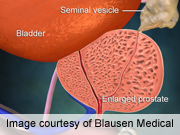
TUESDAY, Jan. 31 (HealthDay News) — Experts comparing three leading prostate cancer therapies find external beam radiation therapy to be more toxic and expensive than either surgery or a more localized form of radiation therapy known as brachytherapy.
The findings were to be presented Tuesday at a meeting in San Francisco, hosted in part by the American Society of Clinical Oncology (ASCO) and focused on prostate cancer.
“Research to date has not given us a clear picture of how each prostate cancer therapy affects men over the long run,” study lead author Dr. Jay Ciezki, a staff physician at the Cleveland Clinic, said in an ASCO news release. “Our analysis is one of the first to examine the quality of life and financial costs of these three very common prostate cancer treatment strategies for more than five years after treatment.
In conducting the study, researchers examined treatment outcomes among more than 137,000 men who received external beam radiation, prostatectomy (surgical removal of the prostate) or brachytherapy (radiation therapy administered directly to the tumor via surgically implanted radiation-emitting “seeds”). They also collected Medicare reimbursement records to determine the total cost per patient per year for each of the three prostate cancer treatments over time.
“We were able to get a good picture of the long-term costs of patient care and were surprised to see such dramatic differences among the three treatment strategies,” Ciezki noted.
The study revealed that overall, just over 7 percent of the men needed some type of follow-up treatment for a problem related to their prostate cancer therapy.
Brachytherapy, the researchers noted, resulted in the fewest number of toxicities involving their genital or urinary organs. Just 3.4 percent of those treated with this therapy experienced these types of problems, such as a narrowing of the urethra or bladder bleeding. Brachytherapy also had the lowest cost per patient per year of about $2,557.
A slightly higher number (6.7 percent) of those treated with prostatectomy experienced problems with their genital or urinary organs. This treatment, the study revealed, had a total cost of about $3,206 per patient-year.
Meanwhile, just over 7 percent of patients who received external beam radiation therapy had these adverse effects. This was also the most expensive therapy, at $6,412 per patient-year. Similarly, 1.7 percent of patients who underwent the treatment had gastrointestinal effects. In contrast, only 0.1 percent of prostatectomy patients and 0.3 percent of brachytherapy patients experienced these issues.
“We found that external beam radiotherapy had higher toxicity rates and was the most costly therapy per patient-year,” Ciezki said. “While there are clearly still some high-risk prostate cancer patients who will benefit from external beam radiotherapy, for the approximately 80 percent or more of prostate cancer patients diagnosed with low- and intermediate-risk disease, brachytherapy or prostatectomy may be even more preferable options than we’ve previously assumed for men with low- and intermediate-risk prostate cancer.”
The researchers pointed out they were not able to determine how far the disease had progressed in each patient and the study was limited to patients older than 65 whose only diagnosed condition was prostate cancer.
They added their findings are preliminary and more research is needed to investigate why the three prostate cancer therapies produce different results and whether or not certain types of patients are more vulnerable to the long-term effects of a particular treatment.
Experts said decisions about treating the individual patient remain specific to that patient and his disease, however.
“The selection of treatment must include a detailed discussion addressing the life expectancy and comorbidities [other illnesses] of the individual, the natural history and curability of the disease, and how the potential complications — like incontinence, lower urinary tract symptoms, erectile dysfunction and rectal symptoms — will impact quality of life,” explained Dr. Herbert Lepor, chairman of the department of urology and director of the Smilow Comprehensive Prostate Cancer Center at NYU Langone Medical Center, in New York City.
He added that while more study into the short- and long-term side effects of different treatment options are sorely needed, the new findings “come as no surprise to those of us who manage prostate cancer based on the mechanism for radiation therapy-induced cellular toxicity.”
Another expert said the new study “makes strides towards evaluating the relative effectiveness of treatments.” Dr. David Samadi, associate professor of urology at Mount Sinai Medical Center, in New York City, said that “while external beam therapy has an important role in the treatment of prostate cancer, these finds suggest we should reserve it for patients who are unable to tolerate other treatment options or have advanced disease, as in the case of adjuvant or salvage therapy.”
However, Dr. Louis Potters, chair of the department of radiation medicine at North Shore University Hospital in Manhasset and Long Island Jewish Medical Center in New Hyde Park, N.Y., said the study may not be the final word on the issue.
“Analyzing claims data is a good way to ‘see’ how patients are treated. Yet, this type of study should not be used to imply that any one treatment is better than another,” he said. “It is up to the treating physician to understand the risks of each therapy. And it’s up to the treating physician to make cogent and unbiased recommendations to patients regarding their best outcome.”
Findings presented at medical meetings are typically considered preliminary until they have been published in a peer-reviewed journal.
More information
The U.S. National Institutes of Health provides more information on prostate cancer.

